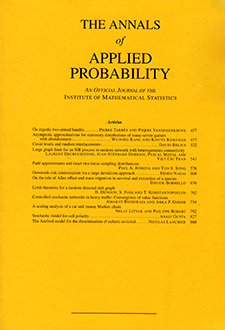Abstract
Consider the motion of a Brownian particle in three dimensions, whose two spatial coordinates are standard Brownian motions with zero drift, and the remaining (unknown) spatial coordinate is a standard Brownian motion with a (known) nonzero drift. Given that the position of the Brownian particle is being observed in real time, the problem is to detect as soon as possible and with minimal probabilities of the wrong terminal decisions, which spatial coordinate has the nonzero drift. We solve this problem in the Bayesian formulation, under any prior probabilities of the nonzero drift being in any of the three spatial coordinates, when the passage of time is penalised linearly. Finding the exact solution to the problem in three dimensions, including a rigorous treatment of its nonmonotone optimal stopping boundaries, is the main contribution of the present paper. To our knowledge this is the first time that such a problem has been solved in the literature.
Citation
P. A. Ernst. G. Peskir. Q. Zhou. "Optimal real-time detection of a drifting Brownian coordinate." Ann. Appl. Probab. 30 (3) 1032 - 1065, June 2020. https://doi.org/10.1214/19-AAP1522
Information





